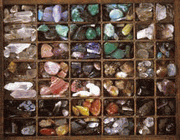Crystals: What are They?

Definition of Crystals
What do stones mean in the context of Mineralogy? Gemstones, semi-precious stones or tumbled stones are minerals which are crystalline in nature and always form in one of six types of regular shapes or patterns, such as the common Quartz Crystal which has a hexagonal (six-sided) structure. Some stones such as Turquoise, may not appear like the typical transparent crystal because their crystal-like structure is at a microscopic level.
Rocks differ from stones in that a rock like Granite or Sodalite is non-homogeneous, which means it is composed of different minerals in varying proportions, in no regular pattern. Any piece will be slightly different from any other piece. All crystals are stones, whether they are clear “gemstones” like Emerald or the more common form of the same mineral, Green Beryl. Rocks may contain crystals, and small rocks are sometimes called stones; but technically, stones are always a single kind of crystal and not a piece of rock. Rocks are often composed of several types of crystals in varying proportions, but in the case of Quartz crystal it is 100% pure crystal.
Gemstones are considered valuable because of their beauty and relative rarity, often because they are perfectly clear and reflect the light in pretty colors. A perfectly clear Ruby, for instance, is a very rare and valuable transparent gemstone specimen of a stone called Red Corundum. A Sapphire is another variety of Corundum, differing from a Ruby only by the tiny quantities of trace minerals which give it a blue or white coloration instead of red.
Amethyst and Citrine are “semi-precious” gem-stone varieties of the common Quartz crystal, which differ only by their coloration
Emerald and Aquamarine are two varieties of the mineral Beryl which differ only by trace mineral content and color.
Types of Crystals
Generator Crystals: Single quartz crystals that can be used in healing to intensify the energy that the healer channels to himself or a client. They can be used to direct the energy flow by pointing the termination (pointed end) in the desired direction. They are very powerful tools and large Generator Crystals should be used with caution.
Crystal Clusters: Formations of single terminated crystals. They can be placed in an area to create a stronger healing vibration or to purify an area of negative vibrations. They can be used to purify and recharge other crystals, healing stones or jewelry by simply placing them on the cluster for at least three hours.
Double Terminated Crystals: These are quartz where the six faces join together to form a point in both ends. These crystals can radiate as well as draw energy from both ends. They are used to dissolve negative energy that is manifested in the physical body or the aura, by placing the crystal over the affected area. Double Terminated Crystals can also be used to relax an unbalanced emotional or mental condition by holding a crystal in each hand.
Tabular Crystals: Flat crystals, two of the opposing six sides are much wider. They are used to balance the energies between any two elements, for example between two Chakras (energy centers).
Programmed Crystals: These can be different types of quartz. They can be large Generator Crystals or Clusters with the terminations pointing in the same direction. To program crystals to send healing energy, hold the termination point towards your Brow chakra (third eye) and concentrate on sending healing energy to a person. To increase the effect, a picture of that person can be placed under the crystal aiming the crystal at the healee. (See Crystal Healing Grids).
